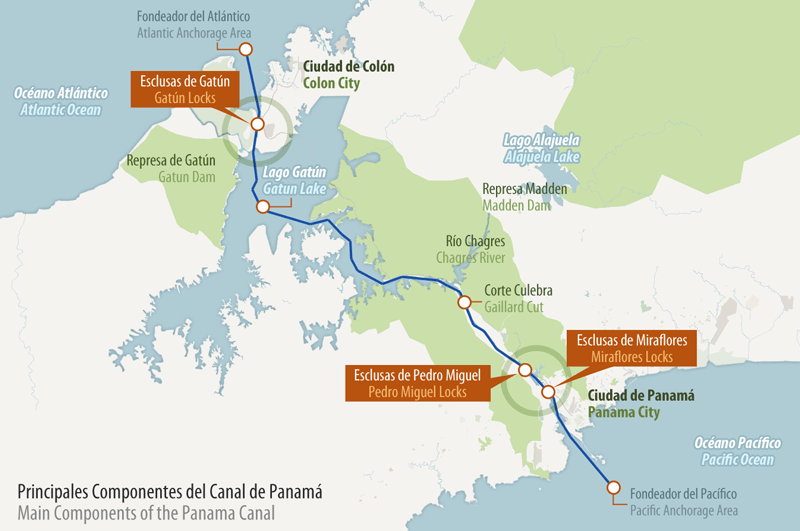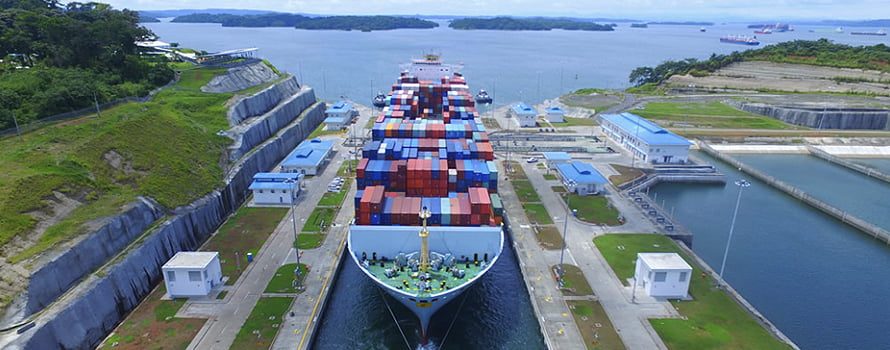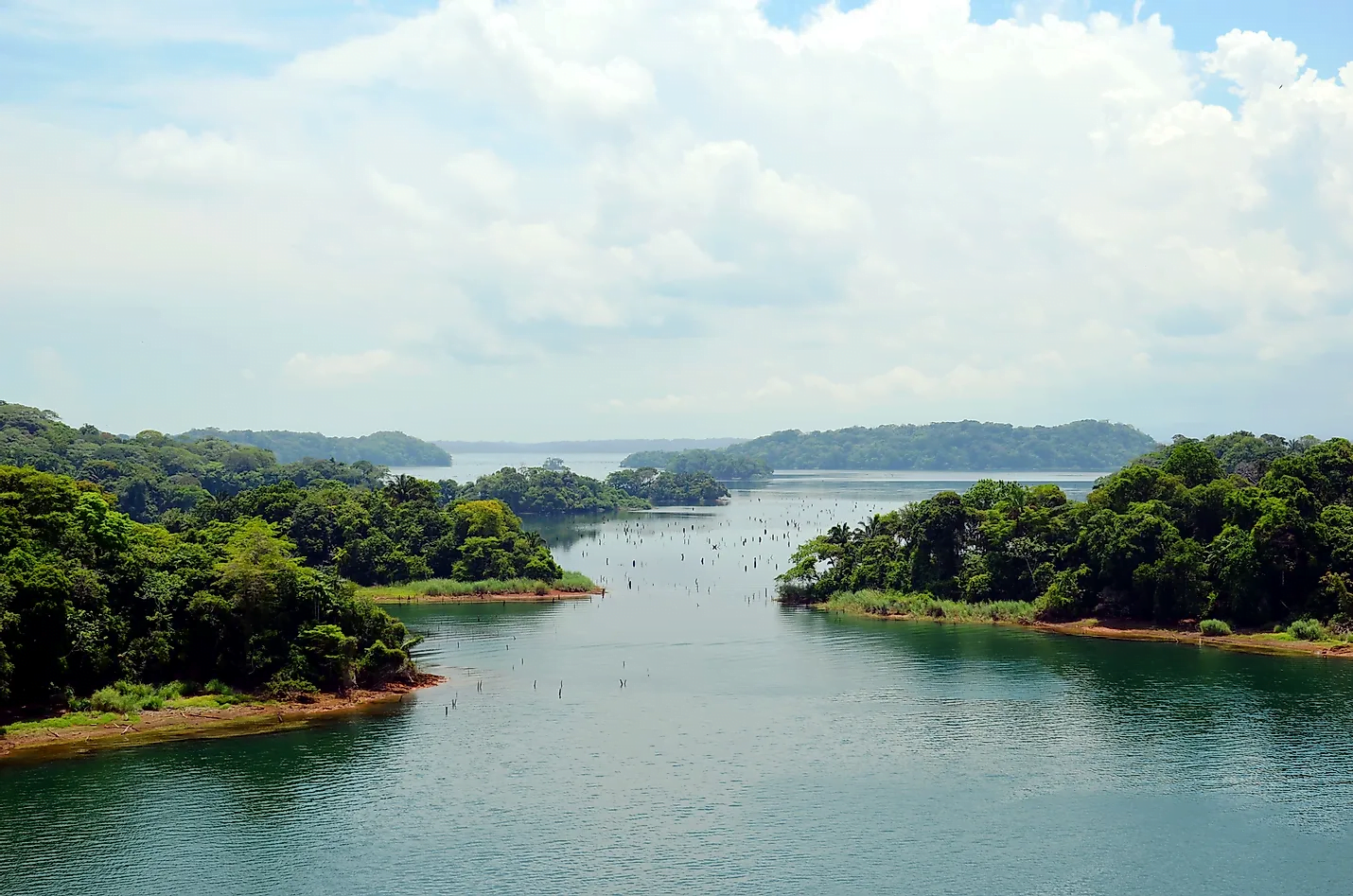Components Of The Canal Infrastructure
Components
The Canal has several main physical components that work in an integrated manner to provide transit services from small floating units to ocean going vessels. These components are the locks, navigation channels, lakes, anchorages and tie-up stations.
Locks
The Panama Canal has three sets of locks: Gatun (on the Atlantic side), Pedro Miguel and Miraflores (on the Pacific Side). The two lanes locks allow vessels to transit in opposite directions simultaneously, if it is required. All three set of locks has different leveling: Miraflores has two-step levels rising the vessel to the Miraflores lake; Pedro Miguel lock has a single level up to Gatun lake; while Gatun, the largest set of locks, has three-step levels to lower the vessel down the Atlantic side.
The lock chambers have the following measures: 33.5 m (110 ft) wide, 304.8 m (1,000 ft) long and 12.8 m (42 ft) deep. These dimensions restrict the vessels to a maximum of 32.3 m (106 ft) in beam; 294.1 m (965 ft) long; and 12.04 m (39.5 ft) tropical fresh water draft.
The Panama Canal Expansion Project will add two additional three-step locks that are 55 m (180 ft) wide, 427 m (1,400 ft) long and 18.3 m (60 ft) deep in order to allow the transit of vessels with more cargo carrying capacity.
Navigational Channels
The Panama Canal navigational channels extend 72 km (45 miles) between the anchorage areas of the Atlantic and the Pacific. These navigational channels vary in width, depth and bank characteristics. The channels are divided as follows:
| Name (Sorted South to North) | From | To |
|---|---|---|
| Pacific entrance | Boya 1P | South-end of Miraflores Locks |
| Miraflores lake | North-end of Miraflores Locks | South-end of Pedro Miguel locks |
| Gaillard Cut | North-end of Pedro Miguel locks | Station 1665 |
| Gatun lake | Station 1665 | South-end of Gatun Locks |
| Atlantic entrance | North-end of Gatun locks | Boya 1A |
Because of the characteristics of each of these channels categories, different operational restrictions exist in order to ensure the safe passage through their waters. These restrictions have a direct impact on the operational flexibility, maintenance requirements and improvement costs.
Read more…Gaillard Cut (or Culebra Cut) is a channel of approximately 13.7 kilometers long that carves through the Continental Divide and connects from the north end of Pedro Miguel Locks to the south edge of Gatun Lake at Gamboa. Its maneuvering space is limited and multiple curves and fog incidence restrict visibility during night time, therefore special restrictions are assigned to large vessels transiting through this area.
Show lessLakes
The transit operations of the Panama Canal depend on the availability of tropical fresh water. The Canal’s original design included the building of dams at the Chagres River and other minor currents to form lakes that store the necessary water for transit operations. These dams formed the Lake Gatun, Lake Miraflores and Lake Alhajuela.
The water storage capacity of these lakes is defined by the physical and operational levels of Lake Gatun which provide the necessary draft in the navigational channels. The Canal manages these lakes along with an integrated hydric system that enables an optimal water usage.
Anchorages and Tie-up Stations
Vessels that arrive at Canal waters wait for their transit at the designated anchorage areas in the Pacific or Atlantic entrances. For operational purposes, there are internal tie-up stations and anchorages (at the lakes or navigational channels) in which vessels can temporary wait without interrupting the transit of other vessels. These locations improve the vessel scheduling flexibility which ultimately increases the number of transits.
Currently, the Canal has the following main anchorage areas and tie-up stations :
| Name (Sorted South to North) | Type |
|---|---|
| Pacific Anchorage | Anchorage |
| Pacific Explosives Anchorage | Anchorage |
| Miraflores Moorings | Berth |
| Cartagena Tie-Up Station | Berth |
| Cucaracha Tie-Up Sation | Berth |
| Gamboa Moorings | Berth |
| Gatun Lake Anchorage | Anchorage |
| Gatun Lake Explosives Anchorage | Anchorage |
| Atlantic Anchorage | Anchorage |
| Atlantic Explosive Anchorage | Anchorage |
New anchorages or tie-up stations are being proposed and developed as part of the continuous improvements of the Canal’s operations. The center walls at each of the current locks can be used as temporary tie-up stations when deemed necessary. The minimum draft requirements at each of the anchorages or tie-up stations are maintained through a dredging program.
From an operational stand point, the anchorages and tie-up stations are important because of their capacity to receive vessels while they wait for appropriate conditions to continue their transit. These conditions may include the wait for daylight (for those vessels that cannot transit the locks or the Gaillard Cut in the dark), fog clearance or mechanical repairs.




